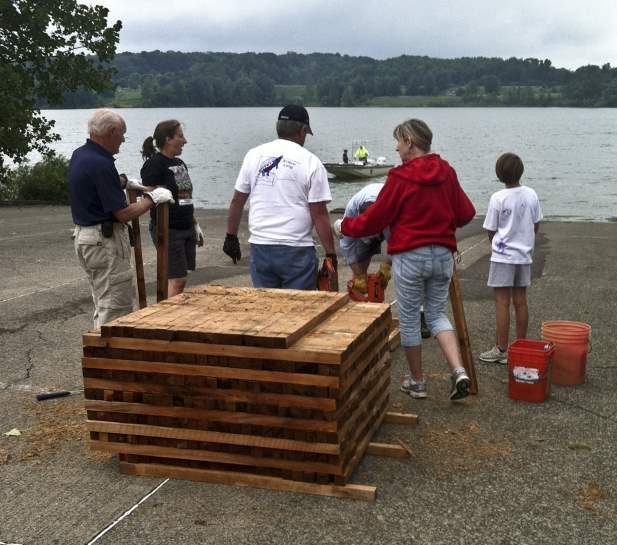Why Anglers Volunteer with Conservation Groups
 Agencies and volunteers partnered to build and install 20 crib structures for fish habitat in Pennsylvania's Woodcock Creek Lake (Credit: Jason Bowers/USACE, via Flickr)
Agencies and volunteers partnered to build and install 20 crib structures for fish habitat in Pennsylvania's Woodcock Creek Lake (Credit: Jason Bowers/USACE, via Flickr)Despite the bad reputation recreational anglers may get when discussing fishery protections, the reality is that many of these anglers are some of the fishery industry’s strongest supporters. A 2014 study sought to answer why many anglers have found their way into various citizen science and conservation organizations. Understanding what draws more volunteers to any project is beneficial for any group hoping to make a difference. Community and stakeholder support is especially important when everyone’s effort is the key to effective management. In particular, anglers’ willingness to step in and volunteer can help protect fisheries in times of stricter budgets.
Stepping up in Times of Need
“Federal budgets are tighter, state budgets are tighter, so volunteers are critical for the management of our natural resources,” said Michael Schuett, study author and associate professor in Texas A&M University’s Department of Recreation, Park and Tourism Sciences.
The study observed responses from 1,888 licensed anglers in Texas to a statewide survey. Of the surveyed fishers, 451 claimed to be a member of a fishing or conservation organization. And of those 451 members, 152 said they volunteer. While the numbers may seem unassuming, that’s around 8% of the anglers that volunteer and about 24% that contribute to organizations. When taken to the national scale—of which the American Sportfishing Association estimated in 2013 an approximate 60 million anglers—the number of anglers willing to step up is much more impactful.
The survey included questions on what makes them volunteer, and the strongest motivations were related to helping and learning about the environment. This group of anglers was particularly interested in enriching activities that they enjoy doing, as well as seeing improvement in the natural areas where they’re working.
In addition to those altruistic motivations, people were also interested in sharing their knowledge with others and meeting people like themselves. “People want to help the environment and do good things, but they also want to meet others who have the same types of interests they do,” Schuett said. “The social aspect is also an important thing.”
Conclusion
The surveyed anglers didn’t appear to be especially interested in volunteering to learn more about public policy or to gain influence over policy discussions. That wasn’t the case with other groups Schuett has studied. For example, volunteers with the U.S. Forest Service wanted to know more about timber sales and play a role in how decisions related to the sales were made.
Schuett said this kind of information has the potential to help natural resource agencies and conservation organizations better sell the benefits of their volunteer opportunities. Recruiting new volunteers will become more important as today’s volunteers grow older: The average age of the survey group was 50, and it’s not clear that the next generation is going to step up in droves.
“My fear is the numbers are going to drop off markedly and then the agencies are going to have to figure out how do to engage these younger folks,” Schuett said. “I think that’s a concern for all of us who are working in the area of conservation. How do we get our younger generation to carry the torch?”
National volunteering statistics have fluctuated in recent years, partly due to the COVID-19 Pandemic and declining free time, but fluctuations have been consistent since the early 2000s. However, as the newer generations are sparked by climate protests across the world, there may still be a fresh set of volunteers waiting to join in on conservation initiatives close to home
________________________________________________________
Top image: On August 13, U.S. Army Corps of Engineers Park Ranger Mike Perry, Jason Bower, supervisory natural resource specialist, Tim Link, maintenance mechanic, members of Pennsylvania Fish and Boat Commission habitat division, members of the Crawford County Conservation district and several volunteers partnered to build and install 20 porcupines crib junior structure. The structures were installed to help improve aquatic fish habitat within the lake and supplement what the type of aquatic habitat that you would find in a lake naturally with artificial fish habitat. Artificial fish habitats are man-made type of structures designed to provide habitat for fish and other aquatic life forms. The structures are designed to increase the abundance of submerged native habitat materials that mimics native or natural habitat found in lakes which many man-made lakes lack. They also provide greater opportunities for anglers. This effort was a part of the Woodcock Creek Lake fish improvement plan developed by the PFBC habitat division. Woodcock Creek Lake Project purchased the supplies and materials, PFBC provided the equipment and boat to build and install these structures and the Crawford County Conservation district provided volunteers. (Credit: Jason Bowers / U.S. Army Corps of Engineers)


Pingback: FishSens Magazine | The Positive and Negative Environmental Impacts of Fishing - FishSens Magazine
Pingback: FishSens Magazine | Undersized Muskie in the Detroit River: How a Viral Video Exposed a Troubling Trend - FishSens Magazine
Pingback: FishSens Magazine | After Lake Champlain bass tournaments, study finds where the fish go - FishSens Magazine
Pingback: FishSens Magazine | Fishing Community Improves Lake Monroe Habitats - FishSens Magazine